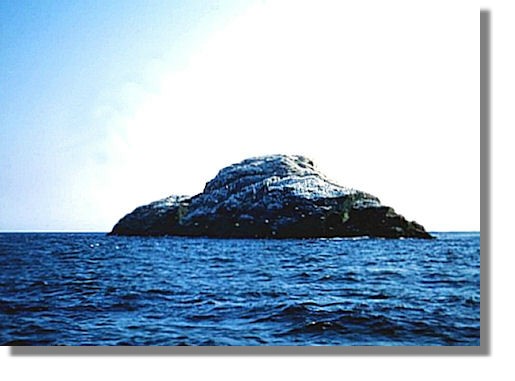

Lighthouse Beacons from Scotland
Sule Skerry Lighthouse

Photo of Sule Stack by David Glass via Wikimedia Commons
Sule Skerry is the most remote Scottish lighthouse stations, acknowledged by the Guinness Book of Records of being the remotest manned lighthouse in Scotland (in fact in Britain). Its position is given in the publicationis given as 35 miles (56kms) offshore and 45 miles (73kms) north west of Dunnet Head, Caithness.
With a surface area of 35 acres, and rising 45 feet above the high water, it is almost out sight of all land but in clear weather the higher ground in Hoy and Sutherland is visible from it. The island, as an old rhyme recalls, was the haunt of seals when it was literally a 'no-man's land' and among the host of sea birds the cheeky puffin predominates - 'the air is black with them, the ground is covered with them, the sea is alive with them', as James Tominson wrote. Charles Tait has captured this deserted lighthouse beautifully with the air full of puffins.
The lighthouse is listed as a building of Architectural/Historical interest.
Sule Skerry lies in the track of vessels passing through the Pentland Firth on passage to or from the Iceland seas. About four miles away rises the stack, 140 feet high, and 15 miles farther south is the sunken Nun Rock, 13 feet below water. Sule Skerry is the home of innumerable puffins and seals and the ground is covered with them. The lighthouse was built in 1892-94 by David A Stevenson and brother Charles. It is 88 feet high with a huge lantern (16 feet in diameter) made to accommodate a powerful 'Hyper-radial' lens. This was replaced with a Dalen Operated gas light with a 4th Order Lens giving a character of Group Flashing (2) white every 15 seconds.
Two seasons were needed for building the 88 foot tower, completed during the exceptionally fine summer of 1893. Winter work was ruled out by the short daylight and stormy weather.
Operational lighting was delayed for a year while the Board of Trade and Trinity House argued with the Commissioners about the cost and character of the apparatus. The new light was observed from Cape Wrath, 35 miles away, on 60 evenings during the first 3 months. Pigeon post was tried as a means of communication to shore but was not successful! And lack of sun hindered an experiment with a heliograph.
The first permanent Radio beacons in Scotland were established in 1929 at Kinnaird Head in March and Sule Skerry in October. The Boards Notice to Mariners stated that they would transmit continuously in thick weather and at ½ hour intervals in clear weather, in order to afford facilities to Mariners for obtaining bearings.
On many occasions Sule Skerry was cut off for days by heavy seas, preventing any landing. But since 1973 this remote lighthouse was relieved fortnightly by helicopter. The Sule Skerry families lived in Stromness from 1895 until the station was made fully automatic in December 1982. The graphic showing a landing at Sule Stack by boat, before the helicopter service began, is by David Glass, via Wikimedia Commons
Return to Index of Lighthouse Beacons from Scotland



